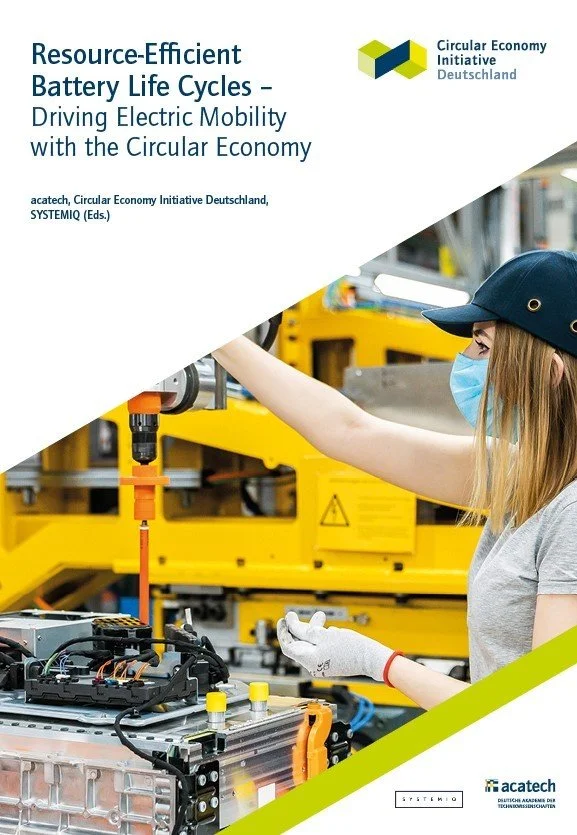Resource-Efficient Battery Life Cycles – Driving Electric Mobility with the Circular Economy
Project: Circular Economy Initiative Deutschland
Published: 06 October 2020
Author / Publisher: acatech, Circular Economy Initiative Deutschland, SYSTEMIQ
The strong growth currently occurring in the global traction battery market is projected to continue in years to come. This trend has huge potential, not only for decarbonising road transport but also for creating new economic value and increasing prosperity. However, it will be vital to minimise the associated environmental and social challenges (e.g. environmental pollution, occupational safety issues and human rights violations) across the entire supply chain, from raw material extraction to recycling.
Circular economy measures have significant potential for reducing material demand and greenhouse gas emissions. Computer modelling shows that, by 2030, 8,100 tonnes of lithium, 27,800 tonnes of cobalt and 25,700 tonnes of nickel could be recovered from vehicles in the German market. Moreover, recycling traction batteries in Germany would deliver cumulative energy savings of 308 petajoules by 2050. This is equivalent to the primary energy consumption of the city of Hamburg in 2019.
The transition to a sustainable, circular battery economy will require measures to be implemented across the entire value chain. To this end, the working group is developing a roadmap and common vision outlining how to achieve a step-by-step transformation between now and 2030. In addition, the three pilot profiles “Understanding of Battery Life”, “Model-Based Decision-Making Platform” and “Dismantling Network for Traction Batteries” set out further implementation steps for topics that will be key to the success of a Circular Economy. Finally, five special focus pieces discuss and make recommendations on a range of issues including battery second life, battery recycling and the role of deposit schemes.
Regulatory measures and incentives initiated by the German government, the institutions of the European Union and transnational corporate partnerships are essential for creating an effective market environment for the traction battery circular economy. These include the creation of a level playing field for the economic actors by harmonising the relevant legislation, clear definitions, common standards and (IT) infrastructure, and incentives for the return and high-quality reuse or recycling of traction batteries. These measures should address various points of intervention in the Circular Economy, including incentives to promote product and system design for circularity, embedding traction batteries in resource-producing ecosystems during use, ensuring a high collection rate at end of life, and establishing appropriate definitions and high, binding recovery rates.
The report “Resource-Efficient Battery Life Cycles – Driving Electric Mobility with the Circular Economy” represents the main outcome of the working group’s deliberations. It discusses the opportunities, obstacles and potential conflicts of a Circular Economy for traction batteries, outlines a vision, presents plans for three pilot projects to accelerate the transformation and formulates recommendations for the main actors. Through this report, the working group’s members hope to support the initiation and long-term consolidation of a Circular Economy in Germany and beyond.
The working group’s 21 members of the Circular Economy Initiative Deutschland are representatives of leading academic institutions, German businesses and organisations known for their expertise in the field of traction batteries. This composition allowed the group to achieve its goal of addressing the topic as holistically as possible.



